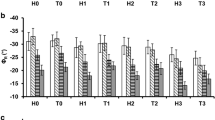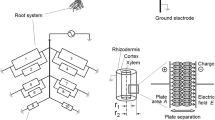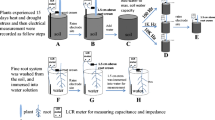Abstract
Electrical impedance spectroscopy (EIS) is investigated as a non-destructive method for monitoring root growth of tomato. This paper aims to (i) review the basic principles of EIS applied to the characterisation of the different parts of the soil–root–stem-electrode continuum, (ii) experiment the validity of the relationship between root weight and root capacitance taking into account the influence of the soil and plant electrodes position, (iii) describe an EIS analysis of the root growth of tomato plants. All experiments were carried out in 50 dm3 containers either in hydroponics at 930 μS for the test of root fresh or dry weight and root capacitance relationships, or in a potting mix (oxisol) for electrode placement tests and EIS estimation of root growth. Electrical measurements of the soil–root–stem-electrode continuum were done with a two-electrode measuring system using unpolarisable Ag–AgCl electrodes. A ‘root cutting’ and a ‘progressively immersed root system’ experiments were carried out in order to validate the relationship between root capacitance and root mass at 1 kHz. The effects of soil electrode and plant electrode placement were also tested, pointing out the sensitivity of the method to the insertion height of the “plant electrode” into the stem. For the root growth experiment, Impedance Spectra (IS) measurements were made just before harvesting the roots for dry weight and length determination. Measurements were made 14, 22, 26 and 39 days after planting, until flowering. The IS of the soil–root–stem-electrode continuum was modelled by a lumped electric circuit consisting of a series resistor R 0 for the soil and of four parallel resistance (R i )-capacitance (C i ) circuits for the other components of the circuit. The model had nine parameters whose values were estimated by Complex Nonlinear Least Squares curve fitting. A stepwise ascendant regression was used to identify the electrical parameters that better correlated with root dry mass or length increment: C 3 and C 4 were well correlated with root dry mass with a r 2 of 0.975, whereas root length was explained by the combination of 1/R 3, C 3, 1/R 2 and 1/R 1 with a r 2 of 0.986. This work may be considered as a new methodological contribution to the understanding of root electrical properties in the non-destructive diagnosis of root systems.
Similar content being viewed by others
References
J J Ackman M A Seitz (1984) ArticleTitleMethods of complex impedance measurements in biological tissues CRC Crit. Rev. Biomed. Eng. 11 281–311
Bourne J R, Morucci J P, Valentinuzzi M E, Rigaud B, Felice C J, Chauveau N and Marsili P M 1996. Bioelectrical impedance techniques in medicine. Crit. Rev. Biomed. Eng., Ed. J R Bourne Vol. 24, Issues 4–6
O Chloupeck (1972) ArticleTitleThe relationship between electrical capacitance and some other parameters of plant roots Biologia Plantarum 14 227–230
O Chloupeck (1977) ArticleTitleEvaluations of the size of a plant’s root system using its electrical capacitance Plant Soil 48 525–532
O Chloupek M Skàcel J Ehrenbergerova (1998) ArticleTitleEffect of divergent selection for root size in field-grown alfalfa Can. J. Plant Sci. 79 93–95
F N Dalton (1995) ArticleTitleIn situ root extent measurements by electrical capacitance methods Plant Soil 173 157–165 Occurrence Handle10.1007/BF00155527 Occurrence Handle1:CAS:528:DyaK2MXntlWisbo%3D
M Dvoràk J Cernohorska K Janacek (1981) ArticleTitleCharacteristics of current passage through plant tissue Biologia Plantarum 23 306–310 Occurrence Handle10.1007/BF02895374
K R Foster H P Schwan (1989) ArticleTitleDielectric properties of tissues and biological materials: a critical review CRC Crit. Rev. Biomed. Eng. 17 25–104 Occurrence Handle1:STN:280:DyaL1M3gvF2jtA%3D%3D
Grimnes S and Martinsen O G 2000 Bioimpedance and Bioelectricity Bases. Academic Press, ISBN-06126303260
Hilhorst M A, 1998 Dielectric characterisation of soil. Doctorat Thesis. Wageningen Agricultural University of Wageningen, 141p
W A Kendall G A Pederson R R Hill (1982) ArticleTitleRoot size estimates of red clover and alfalfa based on electrical capacitance and root diameter measurements Grass Forage Sci. 37 253–256
J R Macdonald (1987) Impedance Spectroscopy: Emphasizing Solid Materials and Systems John Wiley & Sons New York 346
Matsumoto N, Homma T, Morita S and Abe J 2001 Capacitance as a possible indicator for size of maize root system. In Proceedings of the 6th Symposium of the International Society of Root Research. Nagoya, Japan, 578–579
Ozier-Lafontaine H, Bajazet T and Cabidoche Y M 2001 Electrical capacitance as a tool for non-invasive root size estimation: Minimizing soil and electrodes influences. In Proceedings of the 6th Symposium of the International Society of Root Research. Nagoya, Japan, 190–191
G M Preston R A McBride J Brian M Candido (2004) ArticleTitleEstimating root mass in young hybrid poplar trees using the electrical capacitance method Agroforest. Syst. 60 305–309 Occurrence Handle10.1023/B:AGFO.0000024439.41932.e2
K Rajkai K R Vëgh T Nacsa (2002) ArticleTitleElectrical capacitance as the indicator of root size and activity Agrokemia es Talajkan (Agrochem. Soil Sci.) 51 89–98
T Repo T Tuovinen T Savolainen (1990) ArticleTitleEstimation of an electrical model of plant tissue using the impedance locus Silva Carelica 15 51–59
T Repo M I N Zhang (1993) ArticleTitleModelling woody plant tissues using a distributed electrical circuit J. Exp. Bot. 44 977–982
T Repo S Pulli (1996) ArticleTitleApplication of impedance spectroscopy for selecting frost hardy varieties of english ryegrass Annal. Bot. 78 605–609
T Repo G Zhang A Ryyppö R Rikala (2000) ArticleTitleThe electrical impedance spectroscopy of Scots pine (Pinus sylvestris L.) shoots in relation to cold acclimation J. Exp. Bot. 51 2095–2107 Occurrence Handle10.1093/jexbot/51.353.2095 Occurrence Handle1:CAS:528:DC%2BD3MXns1ertg%3D%3D Occurrence Handle11141183
J D Rhoades P A C Raats R J Prather (1976) ArticleTitleEffects of liquid-phase electrical conductivity, water content, and surface conductivity on bulk soil electrical conductivity Soil Sci. Soc. Am. J. 40 651–655
Scharfetter H 1999 Structural modeling for impedance-based non-invasive diagnostic methods. Thesis for the Habilitation. Faculty of Electrical Engineering, Technical University Graz
H Schichlein A Müller M Voigts A Krügel E Ivers-Tiffée (2002) ArticleTitleDeconvolution of electrochemical impedance spectra for the identification of electrode reaction mechanisms in solid oxide J. Appl. Electrochem. 32 87 Occurrence Handle10.1023/A:1020599525160
G Schwarz (1962) ArticleTitleA theory of the low frequency dielectric dispersion of colloidal particles in electrolytes solutions J. Phys. Chem. 66 26–36
P Schwan (1992) ArticleTitleLinear and nonlinear electrode polarisation and biological materials Ann. Biomed. Eng. 20 269–288 Occurrence Handle1:STN:280:ByyD2szhslw%3D Occurrence Handle1443824
K Srinivas P Sarah S V Suryanarayana (2003) ArticleTitleImpedance spectroscopy study of polycrystalline Bi6Fe2Ti3O18 Bull. Mat. Sci. 26 247–253 Occurrence Handle1:CAS:528:DC%2BD3sXhslClurg%3D
A L Thomasset J Lenoir M P Jenin M H Roudlet Cand Ducros (1973) ArticleTitleAppréciation de la situation électrolytique tissulaire par le rapport des impédances corporelles du corps humain en basses et hautes fréquences Revue de Médecine Aéronautique Spot 46 312–315
J Beem Particlevan M E Smith R W Zobel (1998) ArticleTitleEstimating root mass in maize using a portable capacitance meter Agron. J. 90 566–570
M I N Zhang J M H Willison (1991) ArticleTitleElectrical impedance analysis in plant tissues: A double shell model J. Exp. Bot. 42 1465–1475
M I N Zhang T Repo J H M Willison S Sutinen (1995) ArticleTitleElectrical impedance analysis in plant tissues: on the biological meaning of Cole-Cole α in Scot pine needles Eur. Biophys. J. 24 99–106 Occurrence Handle10.1007/BF00211405
Author information
Authors and Affiliations
Corresponding author
Rights and permissions
About this article
Cite this article
Ozier-Lafontaine, H., Bajazet, T. Analysis of Root Growth by Impedance Spectroscopy (EIS). Plant Soil 277, 299–313 (2005). https://doi.org/10.1007/s11104-005-7531-3
Received:
Accepted:
Issue Date:
DOI: https://doi.org/10.1007/s11104-005-7531-3




